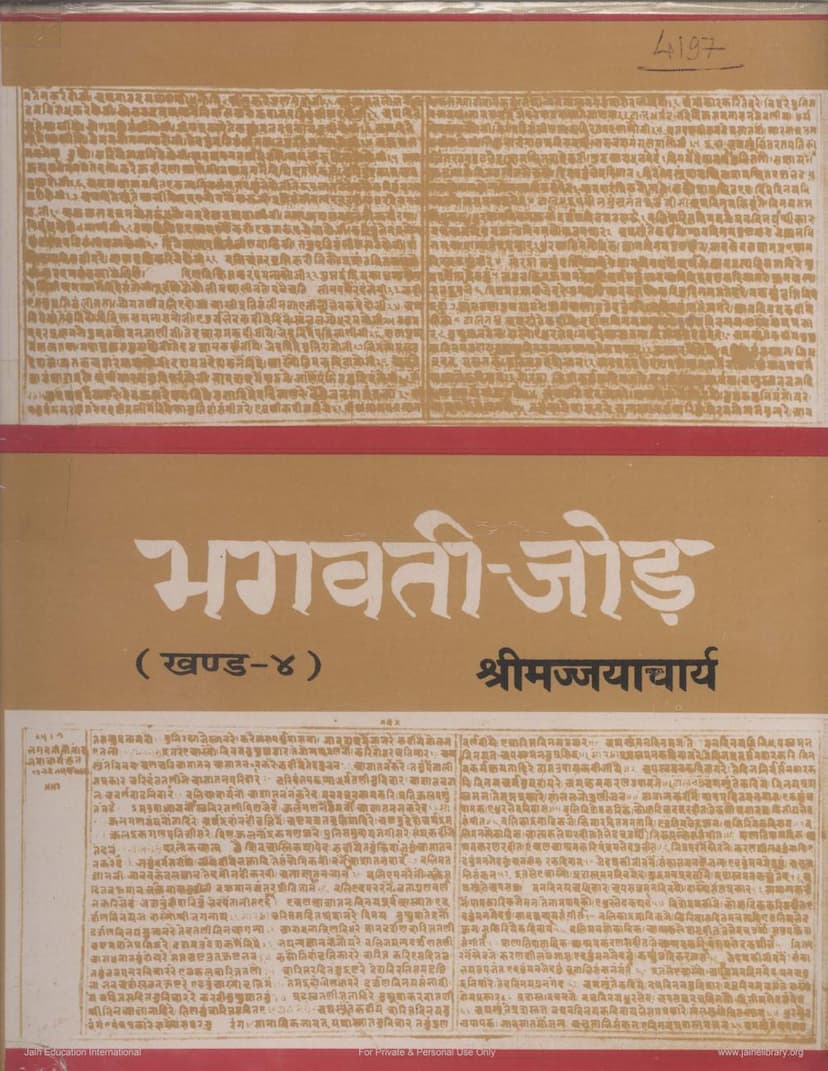Bhagavati Jod 04
Added to library: September 1, 2025

Summary
Here's a comprehensive summary of the provided Jain text, "Bhagavati Jod - Khand 04," based on the translated content:
Overview:
"Bhagavati Jod - Khand 04" is the fourth volume in a series that provides a commentary or poetic rendition (known as "Jod" in Rajasthani) of the Jain Agama text, the Bhagavati Sutra (also called Vyakhya-Prajnapti). This specific volume covers Chapters 12 through 15 of the Bhagavati Sutra, along with a supplement titled 'Goshala ri Chaupai'. The commentary is authored by Acharya Tulsi and Acharya Mahapragna, published by Jain Vishva Bharati. The text presents the original Bhagavati Sutra text alongside its elaborate Rajasthani poetic translation, offering detailed explanations, historical context, and critical insights.
Key Contents and Themes:
This volume delves into significant portions of the Bhagavati Sutra, focusing on intricate philosophical and cosmological discussions, ethical narratives, and the biographies of key figures.
Chapters Covered (Shatak 12-15):
-
Chapter 12 (12th Shatak): This chapter begins with the story of Shanka and Pokhali, two Jain householders, highlighting their adherence to vows and the importance of sincere spiritual practice. It then moves into detailed discussions on the nature of the soul, the causes of its qualities and states, and the intricacies of the twenty-four dandakas (categories or classes of beings) in relation to the concept of pudgala (matter). The chapter explores the composition of matter, the formation of physical entities from atoms and aggregates (sanghata-bheda), and the continuous transformation of matter (pudgala-paravarta). It also examines various philosophical concepts like the causes of attachment and aversion, the nature of knowledge, and the different types of liberation. The text includes detailed descriptions of the seven hellish realms (naraka), their inhabitants, and their characteristics.
-
Chapter 13 (13th Shatak): This chapter continues the exploration of the Bhagavati Sutra, focusing on various cosmological and philosophical topics. It discusses the different types of beings in the Jambudvipa and other regions of the universe, their lifespans, and their migrations (upapata). It details the different types of celestial beings (devas), their abodes, their powers, and their characteristics. The chapter also delves into the nature of the soul (jiva), its various states and activities, and its relationship with matter (pudgala). The text elaborates on the concept of leshya (aura or subtle karmic color) and its influence on beings, as well as the different types of knowledge (jnana) and perception (darshana). The discussions on karma (action and its consequences) are also prominent, explaining how actions lead to bondage and liberation.
-
Chapter 14 (14th Shatak): This chapter continues the philosophical and cosmological discussions. It examines the concept of consciousness (chetana) and its relation to the soul, the nature of hellish beings (nairayika) and their suffering, and the characteristics of various celestial beings. The chapter also explores the different types of beings based on their senses (indriya) and the stages of their development. It further elaborates on the concept of karma and its various permutations, as well as the different states of consciousness and their impact on the soul. The chapter also touches upon the role of leshya in determining the destiny of beings and the nature of liberation.
-
Chapter 15 (15th Shatak): This chapter focuses significantly on the life and teachings of Goshalaka Mankhaliputta, a contemporary and sometimes rival of Lord Mahavira. It details his philosophical views, his claims of omniscience, and his interactions with Lord Mahavira and his disciples. The text portrays Goshalaka's early life, his association with Ajivika mendicants, and his eventual development of unique doctrines. It includes narratives of his debates with the disciples of Lord Mahavira, highlighting their differing perspectives on karma, free will, and the nature of reality. The chapter also discusses Goshalaka's interactions with King Udai, his attempts to gain followers, and his eventual demise, providing insights into the Jain perspective on his teachings and their refutation.
Key Features of the "Bhagavati Jod" Series:
- Poetic Rendition: The series translates the complex philosophical and narrative content of the Bhagavati Sutra into devotional and accessible Rajasthani poetry, making it easier for a wider audience to engage with the text.
- Verse-by-Verse Commentary: Each verse of the original Bhagavati Sutra is presented alongside its poetic translation, providing a comprehensive and detailed explanation.
- Authoritative Lineage: The work is a product of the scholarly and spiritual tradition of Jain Vishva Bharati, reflecting the teachings of prominent Acharyas like Tulsi and Mahapragna.
- Historical Manuscript: The cover page features samples from a handwritten manuscript, showcasing the artistic and scholarly heritage of the text.
Overall Significance:
"Bhagavati Jod - Khand 04" serves as a valuable resource for understanding the profound teachings of the Bhagavati Sutra. It offers a unique blend of scholarly rigor and devotional expression, making complex Jain philosophy accessible and engaging. The volume contributes to the preservation and dissemination of Jain scriptures and their rich commentary traditions.